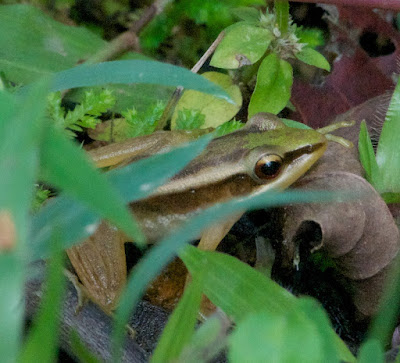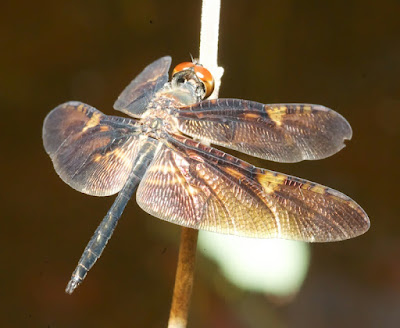On August 19, 2014, I stopped by for another look at one of my favourite dragonfly spots, the MJC forest in Batu Kawa. Despite being on the very edge of urban Kuching, it was still in excellent condition. I am sad to report, as I write this in July 2016, that this is no longer the case; the forest and the roadside ditches are still there, but the locals appear to have been using the area as a garbage dump - so unless a clean-up crew materializes soon, this and some ensuing writeups about MJC may be more in the nature of a eulogy.
Anyway, back in 2014 MJC was still a lovely spot.
Water lilies (Nymphaea sp) still bloomed in the permanent ditches along the road...
...and insects like this little stingless bee (Apidae; Apinae; Meliponini) still visited their flowers.
Golden Apple Snails (Pomacea canaliculata), introduced exotics from the Americas, flourished (and given their durability, probably still do).
Given their sensitivity to pollutants I am not so sure about the local frogs, though the Green Paddy Frog (Hylarana erythraea) apparently survives in heavily-sprayed rice paddies. It may still do so at MJC.
The Grey Pansy (Junonia atlites), a butterfly that seems to prefer open wet areas, was a common sight at MJC, and probably still is.
In 2014 I could expect, on an average visit, to find a dozen species of dragonfly and damselfly around and about the roadside ditches. I saw far fewer in 2016, but it will take more than one brief visit to find out if once-obvious species like Ictinogomphus decoratus have truly left the area. So I can't present a roll-call of missing species at this point (and I hope I won't have to at all).
Brachydiplax chalybea is one of the commonest dragonflies of vegetation-lined ditches, and is still apparently common at MJC.
Rhodothemis rufa (this is a female) was still there in 2016, but a number of others were nowhere in evidence - I hope to find them on a return trip.
Orchithemis pulcherrima (its specific name means "most beautiful") can be somewhat unobtrusive despire its bright colour, so though I failed to find it in 2016 it may still be there.
More surprising to me was the total absence, in 2016, of the genus Rhyothemis. Rhyothemis dragonflies are usually quite obvious, both because of their patterned wings and their distinctive behaviour (the members of the genus are commonly known as "flutterers".
Three species of this genus, including R. triangularis (not shown here) were among the commonest and most noticeable species in the area, and even on a quick visit I was surprised not to see at least one. In 2014 I could always find these strikingly-marked dragonflies at MJC. This is Rhyothemis obsolescens....
...and this is the largest of the three MJC species, Rhyothemis phyllis.
The spectacular damselfly Ceriagrion cerinorubellum is another of the survivors.
It is seemingly the only damselfly to thrive at MJC, but this is not, I suspect, because of the condition of the ditches. Cerinorubellum is a voracious carnivore, devouring every other damselfly in sight.
In fact the only other damselfly I have seen at MJC is an occasional, recently-emerged (teneral) Copera vittata. Like this one, the very few I have found kept out of the way, sheltering beneath tangles of brush.
This photograph, featuring Ceriagrion cerinorubellum, demonstrates the penalty for doing otherwise. I did not, in fact, realize what I was photographing until I zoomed in on my shot later on, when I realized that I had found another teneral Copera vittata that had apparently been pounced on, and was being devoured by, its larger, more colourful and dangerous cousin.



























No comments:
Post a Comment